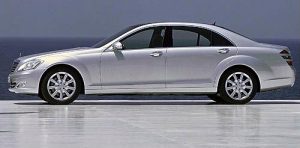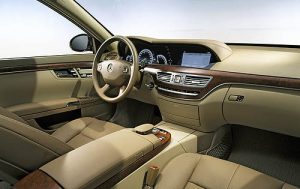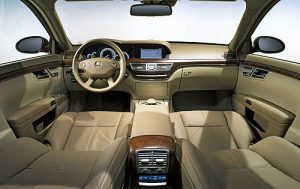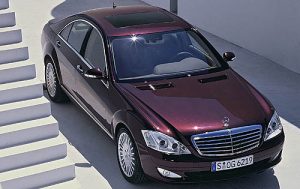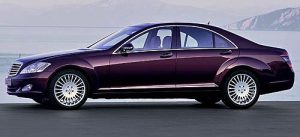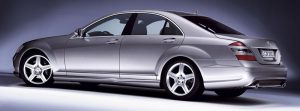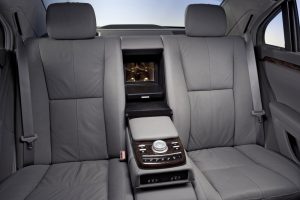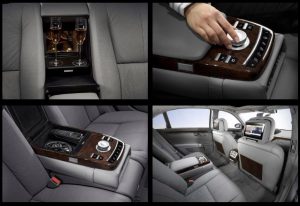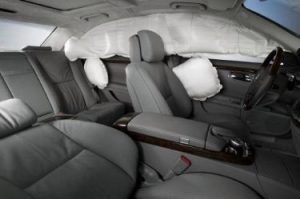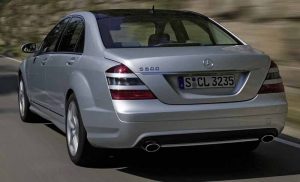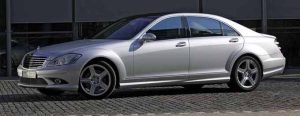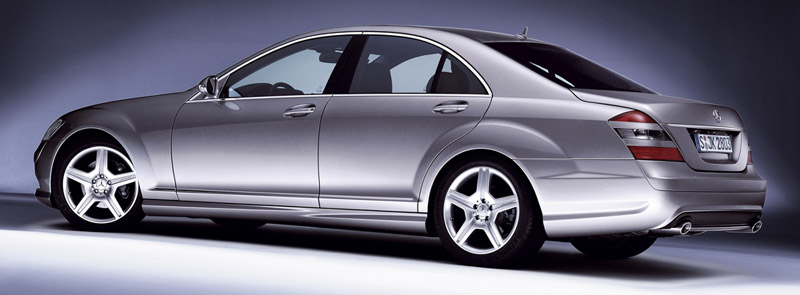
New S-Class Emphasizes Dramatic Design and Advanced Technology
Montvale, NJ – Mercedes-Benz has just released the first official photographs of the next-generation SClass – the company’s new flagship sedan that debuts this fall in Europe and arrives in the U.S. early in 2006. The successor to a long line of premium vehicles, the new S-Class emerges with a stronger presence and a significantly evolved design. Sharper angles and cleaner lines frame a sedan that gains about 1.7 inches of length, almost an inch in width, and more than three inches in wheelbase over its predecessor.
New-Generation Engine for a New-Generation Car
For the 2007 model year, the S600 is powered by a V12 engine with more than 500 hp. The 382-hp S500 is powered by the first of a new-generation V8 engine family featuring increased displacement, four-valve-percylinder technology, variable valve timing and a lightweight crank assembly. Both horsepower and torque are up considerably, yet with lower exhaust emissions and noise. The new S-Class comes with the world’s first 7-Speed Automatic, a smooth-shifting driver-adaptive transmission that maximizes both performance and fuel economy. A small lever on the right side of the steering column serves as an electronic shift lever that’s more convenient than ever – lift the stalk up for Reverse, push down for Drive, and push a button on the end for Park. Once underway, shift buttons on the “back” of the steering wheel provide Touch Shift manual shifting. An electronic parking brake is engaged at the push of a button on the dash, and is released automatically when the driver shifts into gear and touches the accelerator.
More PRE-SAFE Features
During those valuable seconds just before a possible impact, the front seat belts are automatically tightened, the sunroof closes, and the passenger seats can move to positions that provide better protection – three measures that have been part of the revolutionary S-Class PRE-SAFE system since its debut in 2002. On the new S-Class, side windows also close to provide better support for the window curtain air bags, and special seat cushions can inflate to provide greater lateral support for occupants and help the side air bags provide even better collision protection.
Optional Radar System Can Reduce Rear Collisions by 75 Percent
The well-known Distronic cruise control feature that maintains a pre-set following distance behind the vehicle ahead is replaced by an optional Distronic Plus system. Integrated with PRE-SAFE, the radar-based system operates at nearly all speeds up to 125 mph and can be especially helpful in stop-and-go traffic. Distronic Plus works with a new Brake Assist Plus system to monitor traffic conditions, and if a collision is anticipated, ideal brake pressure is applied, even if the driver applies the brake pedal too lightly. In extensive tests using 300 drivers, the new system – another Mercedes-Benz safety first – reduced rear collisions in heavy city traffic by 75 percent. Distronic Plus also incorporates 24 GHz radar-based Park Assist. This new option utilizes six radar sensors mounted behind the front and rear bumpers – eliminating the need for the visible “portholes” of the previous ultrasonic-based system. The result is clean, integrated, and invisible with greater range and sensitivity.
Infra-Red Vision Increases Night Visibility
Another innovative technology making its debut on the 2007 S-Class is infra-red night vision, a new option that can extend the driver’s “visibility” to nearly 500 feet. An industry first, and in contrast to passive systems offered by other auto companies, this active system bathes the road ahead with infra-red light from two projectors mounted in the headlight assemblies An infra-red camera discreetly mounted in the windshield receives the reflected images and displays them in the high-resolution display in the instrument cluster. The result is akin to a highly detailed black & white video image
Form Follows Function Inside and Out
High quality materials used throughout the interior of the S500 are punctuated by sweeping lines of exotic wood accented with chrome trim throughout the cabin, forming a practical yet luxurious environment that emphasizes easy access to vehicle features. The centerpiece of the dash is an eight-inch high-resolution display for an intuitive new COMAND system, now positioned at the same height as the primary instruments and operated by a COMAND Controller located on the lower center console. Instead of requiring occupants to use the COMAND system exclusively, many vehicle controls are accessible by conventional hard keys, the multifunction steering wheel, and optional voice control as well as via the COMAND system.
Newly developed front seats are electrically adjustable 16 ways and offer several optional choices of ventilation and ergonomic adjustability. The available Drive Dynamic seats feature 11 individual pneumatic chambers to help the driver find a perfect seating position, and 14 more chambers provide four levels of pulsating massage to relieve fatigue and help keep drivers alert. For almost five decades, the S-Class has embodied the flagship role for the Mercedes-Benz brand. The SClass is a technological showcase that has pioneered significant safety and comfort features for the entire auto industry.
The engines in the 2007 Mercedes-Benz S-Class:
World premiere of a new eight-cylinder unit – V6 and V12 engines with considerably more output and torque
The engines for the new 2007 Mercedes-Benz S-Class are new or further developments which offer up to 26 percent more output and up to 15 percent more torque then the preceding series. Fuel consumption is reduced by up to nine percent. In autumn 2005 a new 5.5-litre eight-cylinder engine developing 285 kW/388 hp will celebrate its world premiere together with the luxury saloon. The range of outputs from the engines in the S-Class will extend from 173 kW/235 hp in the S 320 CDI to 380 kW/517 hp in the twelve-cylinder S 600.
Mercedes-Benz S-Class: The new V8 petrol engine: Shifting camshafts, an intake module with tumble flaps and optimised airflow ducting help to boost output by 26 percent and make this unit the most fuel-efficient engine in its displacement and performance category by some margin.
The newly developed eight-cylinder unit is the top model in the new generation of Mercedes-Benz V-engines which was successfully introduced in mid-2004. Equipped with four-valve technology, variably adjustable intake and exhaust camshafts, a two-stage intake module and tumble flaps in the intake ducts, the new V8 is among the most powerful yet economical engines in its displacement class. Maximum torque is also significantly improved compared with the previous V8 engine; it has increased by around 15 percent to 530 Newton metres, and is available within a wide engine speed range between 2800 and 4800 rpm. As a result the eight-cylinder powerplant offers driving pleasure more typical of a sports car. The new S 500 accelerates from zero to 100 km/h in 5.4 seconds (previous model: 6.3 seconds).
Mercedes-Benz S-Class V8 petrol engine
Despite the 26 percent higher output, the NEDC (combined) fuel consumption remains at the level of the preceding model at 11.7 to 11.9 litres per 100 kilometres.
Technical highlights in the new eight-cylinder engine also include special shifting camshafts. These reduce the inherent pressure fluctuations in the exhaust train and thereby considerably improve the engine’s gas cycle. This makes itself felt among other things by smoother running and higher torque in the lower and medium engine speed ranges.
The new Mercedes eight-cylinder employs the latest lightweight construction principles, with an aluminium crankcase, low-friction cylinder liners of aluminium/silicon alloy, a forged steel crankshaft and weight-optimised connecting rods. In addition to internal exhaust gas recirculation and secondary air injection, Mercedes-Benz uses two close-coupled catalytic converters with linear oxygen sensors to ensure low exhaust emissions. Thanks to its up-to-date engine technology and efficient emission control system, the new eight-cylinder engine complies with the most stringent exhaust emission standards now in place, and also has the potential to meet the limits planned for the future.
The range of engines for the new S-Class includes the 200 kW/272 hp V6 petrol engine, made in the Stuttgart engine plant.
V6 engine with nine percent lower fuel consumption
The two six-cylinder engines for the new S-Class are likewise new developments. The S 350 is powered by the 200 kW/272 hp V6 engine which entered series production in mid-2004. Compared to the previous V6 petrol engine in the S-Class, the new high-tech power unit delivers around eleven percent more output, while saving one litre of fuel per 100 kilometres. The combined NEDC fuel consumption is 10.1 to 10.3 litres per 100 kilometres. The new S 350 accelerates from zero to 100 km/h in 7.3 seconds, and is therefore 0.3 seconds faster than its predecessor.
New six-cylinder CDI engine and more powerful twelve-cylinder unit from the beginning of 2006
From the first quarter of 2006 the new 173-kW/235-hp V6 diesel engine will be added to the range available for the S-Class. This supersedes the previous in-line six-cylinder unit of the S 320 CDI, improving output by 15 percent. Maximum torque is increased from 500 to 540 Newton metres, which is available between 1600 and 2800 rpm. This up-to-date direct-injection diesel unit is equipped with third-generation common-rail technology. Its advanced features include rapid and precise piezo-injectors, as well as a maximum injection pressure of up to 1600 bar. The maintenance-free particulate filter developed by Mercedes-Benz is standard equipment in the new S 320 CDI in a number of countries.
The new top model in the S-Class will also become available from the beginning of 2006. Thanks to an improved biturbo engine the twelve-cylinder S 600 Saloon develops an output of 380 kW/517 hp –12 kW/17 hp more than previously. Maximum torque increases from 800 to 830 Newton metres.
Mercedes-Benz equips the V6 and V8 models in the new S-Class with the unique 7G-TRONIC seven-speed automatic transmission as standard.
Shifting camshafts, an intake module with tumble flaps and optimised airflow ducting help to boost output by 26 percent and make this unit the most fuel-efficient engine in its displacement and performance category by some margin.

